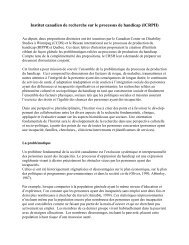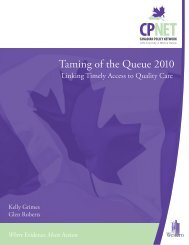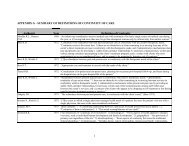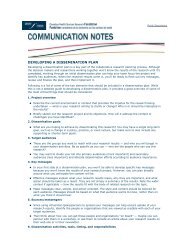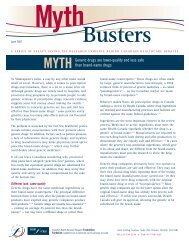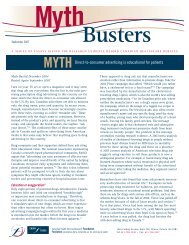Full Report - Fondation canadienne pour l'amélioration des services ...
Full Report - Fondation canadienne pour l'amélioration des services ...
Full Report - Fondation canadienne pour l'amélioration des services ...
Create successful ePaper yourself
Turn your PDF publications into a flip-book with our unique Google optimized e-Paper software.
Implementation of the tool<br />
Sir Mortimer B. Davis – Jewish General Hospital, Hôtel Dieu de Lévis, and Hôpital Charles<br />
LeMoyne were ED research sites that had expressed a firm commitment to this project. These<br />
sites were approached because of their interest, their informatic infrastructure and their<br />
geographical location. However, <strong>des</strong>pite the interest in participation from the major stakeholders<br />
(emergency physicians, primary care givers and directors of EDs), the information technology<br />
department of Charles LeMoyne and Hôtel Dieu de Lévis could not assure the manpower nor to<br />
support the SCS application. The decision to cease collaboration with the 2 centres necessitated<br />
a review of the study methodology.<br />
Study <strong>des</strong>ign<br />
The following elements influenced the choice in study <strong>des</strong>ign. First, a randomized, controlled<br />
though unblinded study <strong>des</strong>ign was necessary to best appreciate the effects of the SCS<br />
intervention. Secondly, family physicians rather than patients were chosen as the unit of<br />
randomization to create two similar cohorts. This decision was mandated by the importance of<br />
preventing contamination within a PCPs practice at any one time. Thirdly, to counter the effect<br />
of any cluster phenomena, it was necessary for all physicians participating in this study to<br />
experience the SCS. Therefore, a triple cross-over <strong>des</strong>ign was employed. The advantage of this<br />
<strong>des</strong>ign also allowed for adjustment of any lag effect that might occur as a result of the learning<br />
phase encountered through the cross-over between the control and intervention arms. The triple<br />
cross-over allowed for each physician to be exposed to 2 intervention periods and 2 control<br />
periods. Finally, to ensure balance in PCP practices, stratified randomization was used to ensure<br />
that PCP were allocated to each cohort according to the age and size of their clientele presenting<br />
to the ED.<br />
Period I<br />
Period II<br />
Period III Period IV<br />
2001/06/15 2001/08/25 2001/11/03 2002/01/18<br />
to 2001/08/24 to 2001/11/02 to 2002/01/17 to 2002/03/22<br />
Cohort #1 n=11 Intervention Control Intervention Control<br />
Cohort #2 n=12 Control Intervention Control Intervention<br />
10




